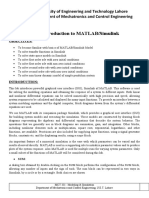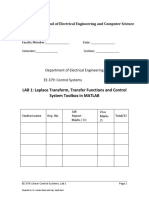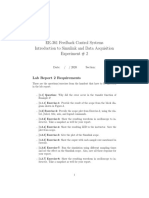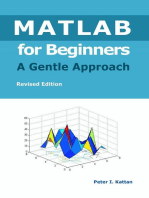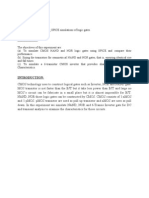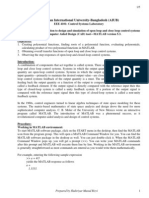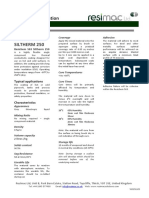0 ratings0% found this document useful (0 votes)
591 viewsControl Lab Report Experiment No. 04
1. The document describes an experiment using MATLAB and Simulink to perform various mathematical operations related to control systems and analyze the performance of systems.
2. Students are asked to use MATLAB commands to perform operations like partial fraction expansion and Laplace transforms, and to model systems using blocks in Simulink to simulate responses to different inputs.
3. Students are to compare step responses for a single order system with and without feedback, as well as responses of a second order system with varying damping ratios, reporting their results.
Uploaded by
Nahin AminCopyright
© Attribution Non-Commercial (BY-NC)
Available Formats
Download as PDF, TXT or read online on Scribd
0 ratings0% found this document useful (0 votes)
591 viewsControl Lab Report Experiment No. 04
1. The document describes an experiment using MATLAB and Simulink to perform various mathematical operations related to control systems and analyze the performance of systems.
2. Students are asked to use MATLAB commands to perform operations like partial fraction expansion and Laplace transforms, and to model systems using blocks in Simulink to simulate responses to different inputs.
3. Students are to compare step responses for a single order system with and without feedback, as well as responses of a second order system with varying damping ratios, reporting their results.
Uploaded by
Nahin AminCopyright
© Attribution Non-Commercial (BY-NC)
Available Formats
Download as PDF, TXT or read online on Scribd
You are on page 1/ 2
1/2
AMERICAN INTERNATIONAL UNIVERSITY BANGLADESH (AIUB)
EEE 4101: Control Systems Laboratory Experiment # 4 Experiment Name: Performing Mathematical Operations and Analyzing System Performance in MATLAB and SIMULINK Objectives: 1. To understand how to perform mathematical operations like partial fraction expansion, simplification, pole-zero determination, Laplace transform, inverse Laplace transform, state-space model generation etc. 2. To understand how to analyze performance of second order systems. Introduction: MATLAB allows designers to perform complicated mathematical calculations in fast and efficient manner. Partial fraction expansion, simplification, pole-zero determination, laplace transform, inverse laplace transform, state-space model generation are some of the mathematical operation that can be very easily performed in MATLAB. Simulink is a companion software that comes with the MATLAB CAD tool that allows designers to model and simulate systems graphically. It allows designers to model systems using block diagrams. Procedure: Part1: Explore Matlab commands like series, cloop, residue, lapalce, ilpalace, syms, pretty, simplify, tf2ss etc as instructed by the teacher. Part2: Find out how to generate plots, provide feedback connections, supply different input signals, describe transfer functions etc. in the simulink environment. Which environment you prefer to model and simulate your system-Matlab debugger or Simulink? Explain your reasons in the lab report. You can find the necessary blocks from the Simulink Library Browser. Locations for some of them are provided below. Transfer Function �Continuous Adder�Math Operations Scope�Sinks Step, Ramp, Sine Wave�Sources Generate the step response for a single order system whose transfer function is 1/(s+5). An amplifier (with a gain = 5) is also connected. Now try to generate the same step response after applying a negative feedback. How can this be done? Compare the two responses. Which response reaches the steady state value first? Which one is better and why? Explain in the lab report.
Prepared by Shahriyar Masud Rizvi
2/2
If time permits, complete the following. Part3: Simulate a sample second order system in Matlab. Model and simulate the same system in Simulink. The general form of the second order system is n2 /(s2 + 2s n + n2). Keep n = 1. Vary the value of (0.1, 0.2. 0.4, 0.7, 1, 2 etc.) and observe the step responses in both environments. Lab Report: Answer the questions posed in the in the lab sheet in the report. Attach your MATLAB code, results, block diagrams and relevant plots.
Prepared by Shahriyar Masud Rizvi
You might also like
- 2021-Jack W Baker-Seismic Hazard and Risk AnalysisNo ratings yet2021-Jack W Baker-Seismic Hazard and Risk Analysis595 pages
- Achieving Coherence in Writing: Transition Words and PhrasesNo ratings yetAchieving Coherence in Writing: Transition Words and Phrases1 page
- Experiment No. 01 Introduction To System Representation and Observation Using MATLABNo ratings yetExperiment No. 01 Introduction To System Representation and Observation Using MATLAB20 pages
- Simulating Control Systems With Simulink and MATLABNo ratings yetSimulating Control Systems With Simulink and MATLAB5 pages
- LAB 1: Introduction To MATLAB and SimulinkNo ratings yetLAB 1: Introduction To MATLAB and Simulink14 pages
- Assignment 1 - Block Diagrams and MatlabSimulinkNo ratings yetAssignment 1 - Block Diagrams and MatlabSimulink6 pages
- DAQ, Simulation and Control in MATLAB and SimulinkNo ratings yetDAQ, Simulation and Control in MATLAB and Simulink21 pages
- Fall 2017 MEGR 4350: Dynamic Systems Laboratory 0 Exercise: Matlab and SimulinkNo ratings yetFall 2017 MEGR 4350: Dynamic Systems Laboratory 0 Exercise: Matlab and Simulink2 pages
- University of Technology: Control and System DepartmentNo ratings yetUniversity of Technology: Control and System Department9 pages
- Experiment No.1 - Introduction To MATLAB and Simulink Software ToolsNo ratings yetExperiment No.1 - Introduction To MATLAB and Simulink Software Tools2 pages
- Experiment 11: To Examine The System Response Using Simulink Library of MATLABNo ratings yetExperiment 11: To Examine The System Response Using Simulink Library of MATLAB8 pages
- Modeling of Physical Systems Using Simulink.: Control System Lab 3No ratings yetModeling of Physical Systems Using Simulink.: Control System Lab 38 pages
- MATLAB and Simulink in Mechatronics EducationNo ratings yetMATLAB and Simulink in Mechatronics Education10 pages
- EE 340: Control Systems Lab 4 Manual Introduction To SimulinkNo ratings yetEE 340: Control Systems Lab 4 Manual Introduction To Simulink13 pages
- EEF460 - Feedback Systems Laboratory OutlineNo ratings yetEEF460 - Feedback Systems Laboratory Outline5 pages
- Laboratory Manual: PC-BTE506 - Control System LaboratoryNo ratings yetLaboratory Manual: PC-BTE506 - Control System Laboratory44 pages
- EE-361 Feedback Control Systems Introduction To Simulink and Data Acquisition Experiment # 2No ratings yetEE-361 Feedback Control Systems Introduction To Simulink and Data Acquisition Experiment # 223 pages
- EEF460_Feedback Systems Laboratory Outline 2025No ratings yetEEF460_Feedback Systems Laboratory Outline 20256 pages
- Report On Business Strategies of Berger Paints Bangladesh LimitedNo ratings yetReport On Business Strategies of Berger Paints Bangladesh Limited19 pages
- 8 Edition: Steven P. Robbins Mary CoulterNo ratings yet8 Edition: Steven P. Robbins Mary Coulter28 pages
- Some Common English Transition Words and PhrasesNo ratings yetSome Common English Transition Words and Phrases3 pages
- Experiment No.: 02 Experiment Name: Objective100% (2)Experiment No.: 02 Experiment Name: Objective11 pages
- EEE 2207: Electrical Machines 1 Course Credit: 3 CP, 3hrs/week Pre-Requisite: EEE-2101No ratings yetEEE 2207: Electrical Machines 1 Course Credit: 3 CP, 3hrs/week Pre-Requisite: EEE-210135 pages
- Optimal Control of A High Gain DC - DC ConverterNo ratings yetOptimal Control of A High Gain DC - DC Converter11 pages
- Atomization For Spray Drying Unanswered Questions and Industrial NeedsNo ratings yetAtomization For Spray Drying Unanswered Questions and Industrial Needs6 pages
- Chapter-Ix - Introduction To Soil Reinforcement TechniqueNo ratings yetChapter-Ix - Introduction To Soil Reinforcement Technique33 pages
- Rean Water Tech Pvt. LTD.: Isolated Footing Design100% (1)Rean Water Tech Pvt. LTD.: Isolated Footing Design5 pages
- Systems Engineering - 2023 - Scalco - A Model For Measuring Multi Concern Assurance of Critical Infrastructure ControlNo ratings yetSystems Engineering - 2023 - Scalco - A Model For Measuring Multi Concern Assurance of Critical Infrastructure Control12 pages
- Advantages and Disadvantages of air coolerNo ratings yetAdvantages and Disadvantages of air cooler152 pages
- Application of Integrals: Date: ..............No ratings yetApplication of Integrals: Date: ..............8 pages
- Microprocessor_Lab_Manual Final for PrintNo ratings yetMicroprocessor_Lab_Manual Final for Print19 pages
- ELTR 270 - Diode Practice Problems and Solutions100% (1)ELTR 270 - Diode Practice Problems and Solutions33 pages
- Science Process Skills: Observe Classify Measure Infer Predict Credits Extensions About The AuthorNo ratings yetScience Process Skills: Observe Classify Measure Infer Predict Credits Extensions About The Author21 pages
















